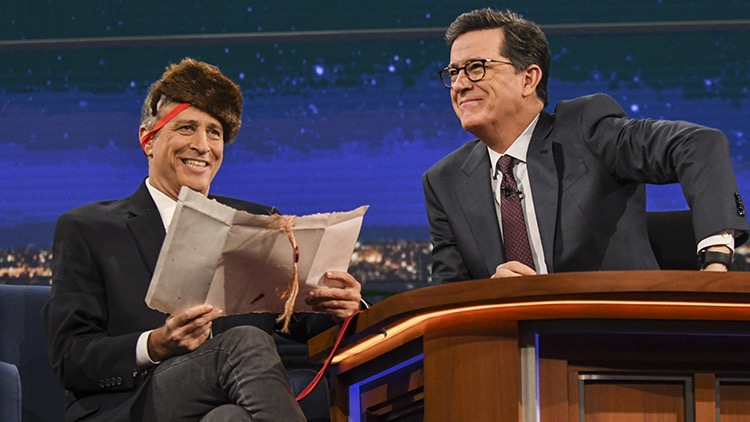Night Fever

In the world of late-night comedy, the hosts have been incredibly busy for weeks, building a wall. It’s gonna be the best. You can already see it. It’s orange. It’s so big already; not small, like some people say.
Let’s call it a wall of sound, a relentless trove of jokes related to the combative first weeks of the Trump administration. As ratings go, it’s getting more solid as time moves on.
On the day when North Korea test-launched a new missile and Trump was discussing strategy in full view of the public while dining at his Mar-a-Lago property, Jimmy Kimmel joked on ABC’s Jimmy Kimmel Live! that, in the end, Trump and his advisers “decided to impose more sanctions—and split a tiramisu.” Later, going over a series of “White House Valentine’s Day cards,” Kimmel revealed one from Steve Bannon reading, “Will you be mein?”
On NBC’s The Tonight Show, daypart leader Jimmy Fallon said all the current turmoil led to the necessity of a new Secret Service name requested by the president: “Hugh Jands.”
But things were nastier on CBS’ The Late Show, where Stephen Colbert has apparently upped his game. Since his strangely apocalyptic live Showtime special on election night, Colbert has grown angrier in his political humor and commentary—a throwback, of sorts, to his days on The Colbert Report on Comedy Central. On that same day, along with delivering a number of North Korea-test barbs, Colbert played clips of Trump adviser Stephen Miller asserting illegal presidential election voting on the weekend morning shows. Among Miller’s statements: “The powers of the president to protect our country are very substantial and will not be questioned.” To which Colbert said, “Will not be questioned? Let me test that theory: What the f--- are you talking about?” The result: a 20-second rousing ovation from his audience.
The other result Colbert has seen of late: Higher ratings. For the week ended Feb. 5, The Late Show did something it hadn’t since Colbert’s premiere week of September 2015: It topped NBC’s The Tonight Show in total viewers. It was a tiny win (2.77 million to 2.76 million) but a win nonetheless—one that was repeated the following week.
It’s certainly a new chapter in the late-night wars, and while not as personally ugly as the Jay Leno-David Letterman steel cage match, they’re more competitive, with the age of the web, the DVR and every last YouTube clip completely complicating the tabulation for what ratings success really means.
Broadcasting & Cable Newsletter
The smarter way to stay on top of broadcasting and cable industry. Sign up below
Fallon rules, but the guy who scored 10 million average viewers three years ago is mired in daily competition with Colbert and Kimmel, and Trump helped. After being the only late-night host to average better than 3 million viewers per night for years (and keep in mind: Johnny Carson’s farewell week saw him bringing close to 20 million per show), Fallon has fallen to earth. What’s more significant: While Colbert is still battling Kimmel in the 18-49 demo (.48 vs .45, respectively, in the week ended Feb. 3), he’s left Kimmel (2.06 million) in the dust in viewers. Meanwhile, Trump-antagonizer Seth Meyers of NBC’s Late Night maintains a sizable lead over CBS’ The Late Late Show and James Corden, master of Carpool Karaoke. And Samantha Bee’s Full Frontal on TBS is routinely among cable’s top-20 weekly gainers over the seven-day ratings period.
If the trend continues, it’ll be because the new Trump era has created a massive roiling sea of media mystification, from “fake news” to “alternative facts” to one frustrated—and blissfully parodied—press secretary on Saturday Night Live.
But it has also birthed the new late-night competition, where both broadcast and cable hosts continue to build that wall using the same raw materials but vastly different styles, part of a clarion call to a creative resurgence among all late-night players. The operative questions are, how far will it go, and will it bring higher numbers to the daypart—and who will win?
Mock and a Hard Place
“At a time where there’s emotional upheaval, there needs to be what amounts to an escape valve,” Bill Carroll, senior VP, director of content strategy for Katz Television Group, said. “If Johnny Carson ever made you look foolish, it would be difficult to turn that around and have people believe you to be serious. But the approach has changed, most recently under Jon Stewart, augmented by Stephen Colbert. There is more direct mocking of what’s taking place.”
Mocking politics has become one of the most popular spectator sports in America. Ratings for Late Night have risen since Meyers cemented his anti-Trump commentary in the late-late daypart (though he’s on right after Fallon, being on later makes it more palatable for NBC). Trevor Noah, current host of Comedy Central’s The Daily Show, has found his stride—and more viewers— while filling Stewart’s big shoes. Bee has carved out her own angry niche on TBS with Full Frontal. And John Oliver saw his biggest Last Week Tonight numbers yet on HBO with a much-watched segment on “Donald Drumpf.” His return to the HBO show last week featured another 23-minute-long shot vs. the ever-exhausting president, setting the tone for the screed with, “Since taking office around 412 years ago, Trump has made it clear that reality is not important to him.”
To these hosts, the idea of mussing up Donald Trump’s hair—as Fallon did before the election, making him seem somehow teddy-bear sweet—is as astounding as, say, an actual massacre in Bowling Green.
And that accentuates the country’s great divide between the two ideas of late-night, which has long been both a place to laugh and settle in for bed, and a place to laugh at something that would otherwise keep you up at night. Nobody was ever better at tucking in Americans than Carson, whose Midwestern sensibility made for—generally—kinder, gentler barbs on The Tonight Show from 1962 to 1992. His Tonight successor, Jay Leno, followed suit, and you can still find a healthy trace of that in the every-day-is-a-party offerings of Fallon, and the less-biting joking of Kimmel.
But the vein of late-night TV comedy with a harsher, in-your-face set of smarts seemed to emerge in primetime with the short 1960s run of The Smothers Brothers Comedy Hour. That series weekly tested the social and political waters—and the patience of sponsors— while Richard Nixon reigned in America, until it was cancelled…but not before making it somehow OK for comedians on television to mock the authority of the president. If Nixon famously said “Sock it to me?” on popular party show Rowan & Martin’s Laugh-In, the Smothers Brothers took it literally.
That continued in large part thanks to David Letterman’s late-night NBC and CBS shows, and in larger part to Stewart, who emerged as the biggest late-night influence during his 1999-2015 Daily Show run on Comedy Central.
Colbert’s rise in the ratings coincided with Stewart’s recent guest appearance on his old friend’s show. Walking out in a tie long enough for four men and wearing what looked like a dead ferret on his head, Stewart was clearly there to feed Colbert’s re-embraced deeper, darker political sentiment.
After Trump’s startling 20 executive orders in his first 10 days in office, Stewart—in a lengthy clip seen on YouTube around 7 million times—added up Trump’s next set of executive orders. How to deal with the proposed wall at the Mexican border? “China shall immediately send us their wall—done. Boom! Done!” declared Stewart. As to getting the Mexican government to foot the bill? We’ll have it delivered COD and just not be there so Mexico would have to pay for it.
Getting Spice-y
While it’s not part of the daily late-night grind, it’s worth mentioning that, as it did four years ago and eight years ago, Saturday Night Live is also finding both a creative and ratings swell by getting under the thin skin of the administration, particularly due to Alec Baldwin’s Trump impression—a cross between the president and Flattop from the old Dick Tracy comic strip. “Just tried watching Saturday Night Live—unwatchable! Totally biased, not funny and the Baldwin impersonation just can’t get any worse. Sad,” the president tweeted in early December. “@NBCNews is bad but Saturday Night Live is the worst of NBC. Not funny, cast is terrible, always a complete hit job. Really bad television!” he tweeted in mid-January, to which Sean Spicer added that the show “used to be funny.”
Well, it’s rarely been funnier than with Melissa Mc-Carthy now aboard, playing Spicer with hilariously angry venom, and a motorized podium with which she can mow down members of the media that insist on asking actual questions. Responding to one such query about whether the immigration ban was, as Trump had said, really not a ban, McCarthy-as-Spicer shouted, “I’m using your words! You said ban. You said ban. You just said that. He’s quoting you. It’s your words, he’s using your words, when you said the words and he’s using them back, it’s circular using of the words and that’s from you!”
Said Carroll: “This is the genius of [SNL executive producer] Lorne Michaels. Who would have guessed Melissa McCarthy as Sean Spicer? But this is the environment they’re operating in.”
Time Is of the Essence
It’s the environment all the hosts find themselves in daily during the 11:30 or 12:30 hour. And as the anger rises, so do some of the numbers. While Colbert inches ahead in total viewers, Fallon (.67) still led Colbert (.48) and Kimmel (.45) in the 18-49 demo ratings for the week Jan. 30-Feb. 3. All things considered, it’s a pretty swift turnaround from numbers going back to late August, when the demo ratings had Fallon (.81) topping Kimmel (.41) followed by Colbert (.39).
All boats naturally rose in the days after the election, with Fallon (.98) holding a sizable lead in the demo in the last week of November over Colbert and Kimmel (both at .49), and Fallon boasting 430,000 more total viewers. Now, the fomenting actions in Washington seem to have leveled the playing field. The swiftness and strange brevity of the news cycle makes cracking wise well that much harder, but it’s clear that Colbert is seizing an opportunity and plans to make his own wall of sound about the president solid and sure. And it appears to be moving ever higher.
“These feel like unprecedented times,” Carroll said. “And it takes on a different scope, because everything in the news cycle is constant and considered suspect. And it’s impossible not to be aware of what’s going on.
“And as a result, everyone has an opinion, and everyone starts to look at things with a certain sense of humor—or lack thereof. And that goes all the way to the top.”
Rob has written for Broadcasting+Cable since 2006, starting with his work on the magazine’s award-winning 75th-anniversary issue. He was born a few blocks away from Yankee Stadium … so of course he’s published three books on NASCAR, most notably, Full Throttle: The Life and Fast Times of NASCAR Legend Curtis Turner. He’s currently the special projects editor at TV Guide Magazine. His writing has appeared in The Washington Post and his origami art has been in The Wall Street Journal. He lives with his family in New Jersey and is writing a novel about the Wild West.

